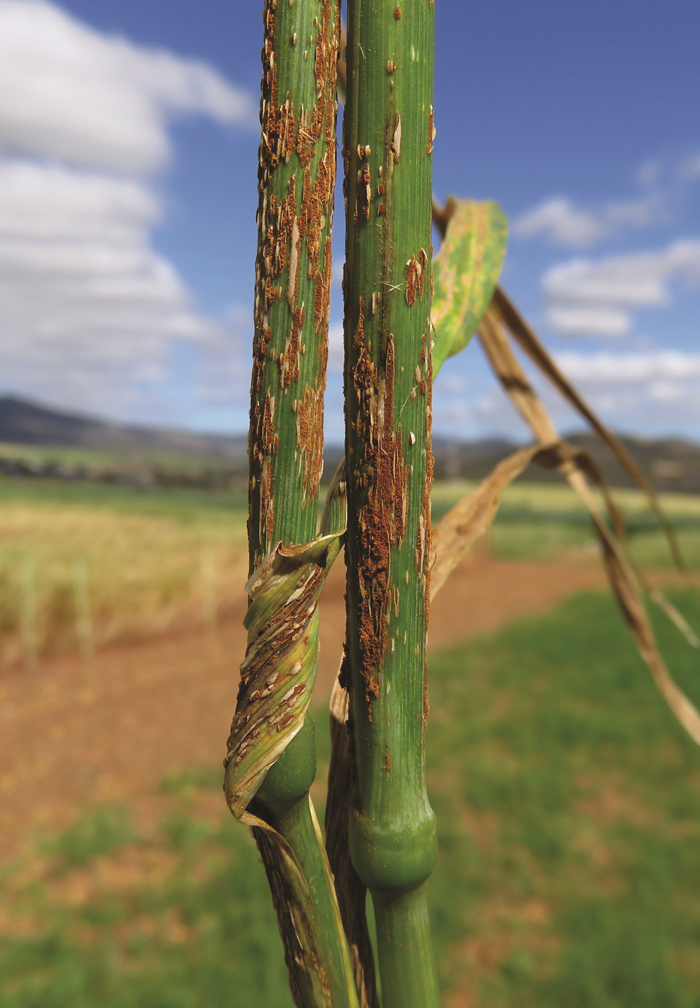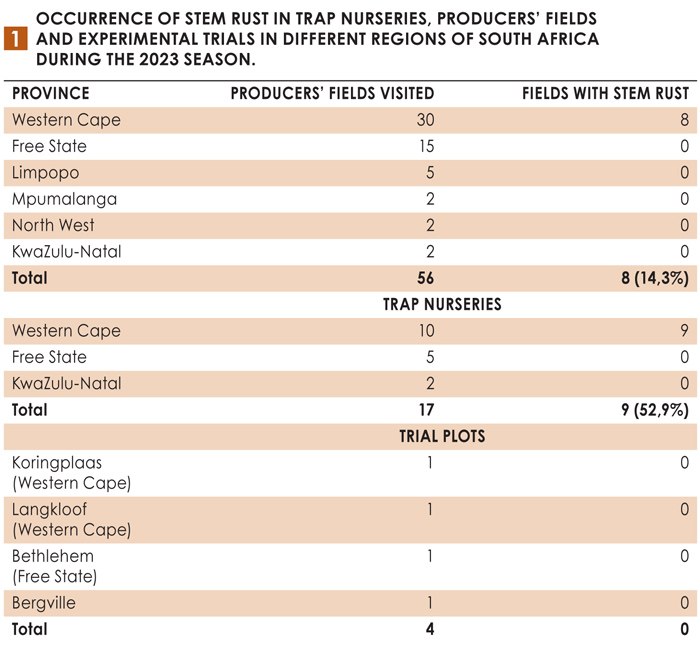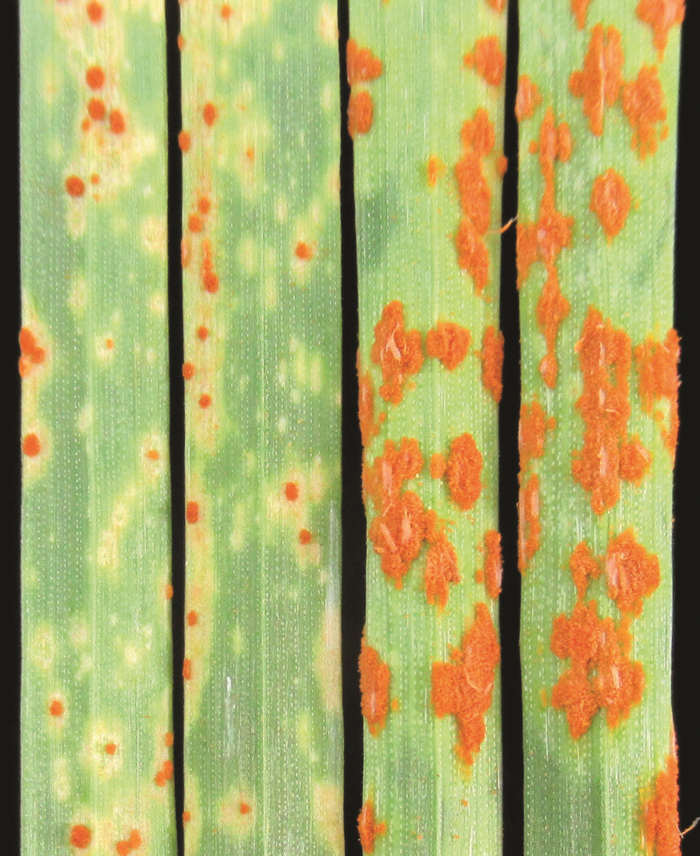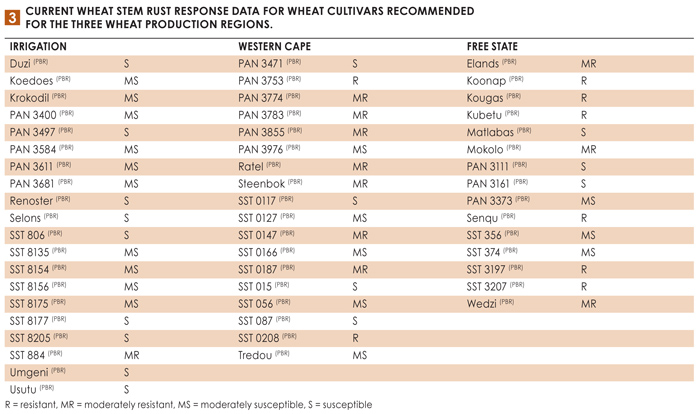

Prof Willem Boshoff, Department of Plant Sciences, University
of the Free State

Prof Zakkie Pretorius, Department of Plant Sciences, University
of the Free State
Stem rust caused by the fungus Puccinia graminis f. sp. tritici (Pgt) is one of the important diseases of bread wheat in South Africa. Typical symptoms of stem rust include dark-red, elliptical pustules occurring mainly on the stem of infected wheat, often coalescing and rupturing the plant epidermis (Photo 2).
This disease is more frequently observed in the winter rainfall regions of the Western Cape and occasionally in the Free State and KwaZulu-Natal provinces. Stem rust is potentially one of the most destructive diseases of wheat. Locally, nearly 50% yield loss due to stem rust has been reported from trials (Soko et al., 2018). Localised stem rust outbreaks have also been observed in commercial fields in recent years. For example, an outbreak of stem rust on summer-planted wheat near Bethlehem in the eastern Free State during 2020 resulted in significant yield and quality losses (Terefe et al., 2024).
During October 2023, severe stem rust infection was observed in a wheat field planted with a susceptible cultivar at Roodebloem near Caledon in the Western Cape. Observations in the Overberg revealed severe stem rust infection in a wheat field not protected by fungicide sprays in the same year. Of further interest were stem rust infections observed during mid-July 2023 in triticale planted as a cover crop in a vineyard near Paarl. Spores from such early-season infections on unsprayed forage or cover crops of triticale will most likely serve as inoculum to cause outbreaks on susceptible wheat cultivars.
Resistant cultivars provide effective and environmentally safe control of stem rust. However, successful breeding and deployment of resistant cultivars depend on knowledge of the variability of the causal pathogen. This is because the stem rust pathogen can evolve to form new strains (races) which can overcome deployed sources of resistance resulting in epidemics and economic loss. Therefore, rust monitoring is considered essential to timeously detect new races, to determine their effect on cultivar responses and to provide early warning about possible threats. Rust monitoring also helps in the identification of effective resistance genes which can be used in resistance breeding. Annual stem rust surveys and virulence studies have been conducted in South Africa since the early 1980s by ARC-Small Grain and collaborators from the University of the Free State (UFS).

Outcomes from these studies include early detection and warning about the impact of new Pgt races and have made a significant contribution to stem rust resistance breeding in South Africa. As part of ongoing rust monitoring, the present survey was conducted during the 2023/2024 season across the major wheat growing regions, including the Free State, KwaZulu-Natal, Western Cape, North West, Limpopo, and Mpumalanga. Trap nurseries planted at 17 localities and more than 56 commercial wheat fields and experimental plots were covered. Stems of wheat and triticale infected with stem rust were collected and spores from these samples were inoculated onto seedlings of a set of standard differential lines to identify the Pgt races.
Occurrence of stem rust
Stem rust was observed in more than 50% of the trap nurseries. In the Western Cape, the disease was found in nine of ten trap nursery localities (Table 1). However, disease severity at most of these localities was low (<20%). Over 60% stem rust severity was noted on a few susceptible entries at Langkloof and 40% to 60% severity at Porterville and Hopefield. Eight (27%) of 30 producers’ fields surveyed in the Western Cape showed trace infections with stem rust except for one field at Roodebloem where over 65% severity was recorded late in the season. Stem rust was not detected in producers’ fields, trap nurseries or trial plots surveyed in the Free State, KwaZulu-Natal, North West, Limpopo, and Mpumalanga (Table 1).
 Stem rust races detected
Stem rust races detected
Four stem rust races were identified from 67 isolates pathotyped at the time of writing this article. Races 2SA5 (51%) and 2SA46 (37%) were most common followed by 2SA105 (10%) and 2SA104 (2%) (Table 2). Races 2SA5 and 2SA46 were widely found in the Rûens and Swartland regions of the Western Cape during the 2022 season as well. Race 2SA5 was detected for the first time in the Western Cape in 2017 and has been frequently found in this province since 2020. Although 2SA5 is less virulent compared to other stem rust races and therefore described as less threatening to local wheat production (Terefe et al., 2024), it has been identified from stem rust found on SST 0117 and SST 88 during the 2023 season.
 The other three races detected in the present survey – 2SA104, 2SA105, and 2SA46 – mainly infect triticale and are mostly found in the Western Cape due partly to the growing of susceptible triticale cultivars as pasture or cover crops in this province. However, like 2SA5 these races can cause stem rust on the wheat cultivars SST 0117, SST 88, and SST 056.
The other three races detected in the present survey – 2SA104, 2SA105, and 2SA46 – mainly infect triticale and are mostly found in the Western Cape due partly to the growing of susceptible triticale cultivars as pasture or cover crops in this province. However, like 2SA5 these races can cause stem rust on the wheat cultivars SST 0117, SST 88, and SST 056.
Race 2SA46 is a relatively new race which was first detected in 2022 in the Western Cape, and it is phenotypically related to the existing races infecting triticale (Table 2). Based on a test on the standard differential lines, 2SA46 is virulent to the resistance gene Sr8b, unlike previously known triticale races (Photo 1). Race 2SA46 has been widely found in the Western Cape during the 2023 season. To assess the risk of this new race on local wheat production, current South African cultivars and breeding lines were evaluated at UFS. Seedling infection type data indicated similar low and high responses for this race compared to 2SA105 on a set of 131 wheat entries representative of all the local breeding programmes. Table 3 contains a summary of the current wheat cultivar response data to stem rust.

 Conclusion
Conclusion
Stem rust was found in the Western Cape during the 2023 season, but not in wheat fields surveyed in the Free State, KwaZulu-Natal, North West, Limpopo, and Mpumalanga. The distribution and severity of stem rust was higher in the trap nurseries than in commercial wheat fields which can be attributed to the application of fungicides by producers. However, localised stem rust outbreaks have been observed in some commercial wheat fields in 2023 and previous seasons indicating the potential threat to wheat production, particularly in the Western Cape. Four stem rust races were identified from the 67 isolates pathotyped.
Although no new stem rust races were identified in 2023, race 2SA46 (which was first detected in 2022) has been widely found in the Western Cape in 2023. Infection studies on current South African commercial wheat cultivars and breeding lines suggested that race 2SA46 does not pose any increased risk to local wheat production when compared to existing races.
References
- Soko et al. 2018. Yield loss associated with different levels of stem rust resistance in bread wheat. Plant Dis. 102: 2531-2538.
- Terefe et al. 2024. Wheat stem rust surveillance reveals two new races of Puccinia graminis f. sp. tritici in South Africa during 2016 to 2020. Plant Dis.108: 20-29.
Acknowledgements
The South African Winter Cereal Industry Trust and the Department of Agriculture, Land Reform and Rural Development are acknowledged for funding the project.



























